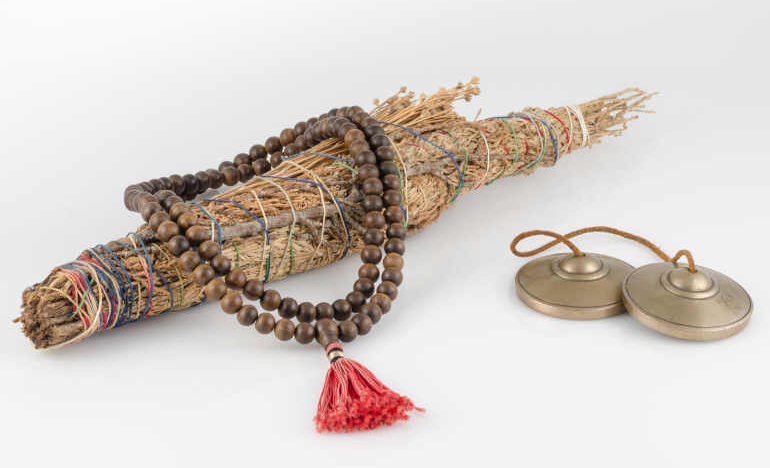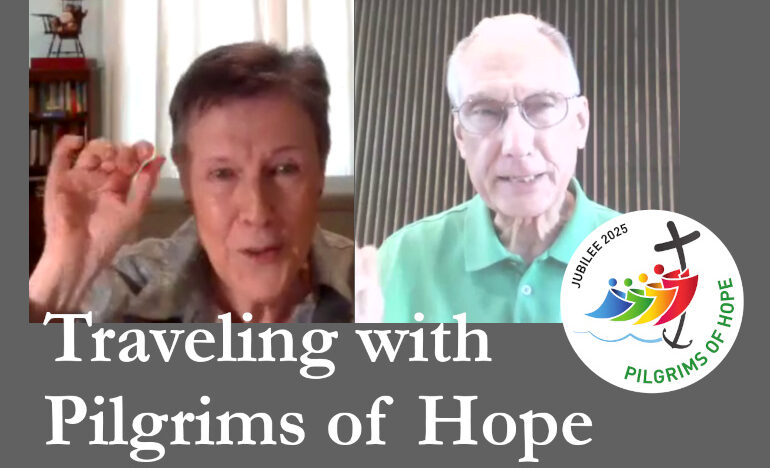Chants, Beads and Mantras: Solemn Practices of Christians and Buddhists

By Kathy Keary
Part 6. Read all the parts of the Jesus and Buddha series here.
As we continue to explore solemn practices in both the Christian and Buddhist traditions, we refer you to our previous articles on meditation. Today we will turn our attention to other sacred practices exercised in both faiths.
In the Christian tradition, prayer is directed to God. This is not the case in Buddhism, which is a nontheistic way of life. A supreme god or deity is not acknowledged. The focus of Buddhism is to achieve enlightenment, a state of inner peace and wisdom.
The examen
The examen is a Christian practice that has its roots in ancient times. At the end of the day, one reflects on God’s presence throughout the day and discerns God’s guidance. Jesuit Fr. Dennis Hamm likens the examen to “going through a drawer full of stuff, feeling around, looking for something you are sure must be there.” In the process, the searcher finds God active in their life or perhaps becomes aware of their resistance to the divine. This thoughtful reflection helps the individual to become more the person they were created to be. The following video elaborates on the examen found in Ignatian Spirituality, The Examen Video – IgnatianSpirituality.com.
A similar examination of conscience is found in the Buddhist tradition. The following is an example that is meant to be recited slowly and mindfully at the end of the day.
The day has ended and my life is shorter.
Now I look deeply. What have I done?
Have I helped put an end to suffering for myself or another?
Have I brought happiness to myself or another?With all my heart
I vow to live diligently.
Aware of impermanence.
Committed to kindness.
Understanding.
And joy.
The Mantra
Another Christian custom that finds its origin in antiquity is the utterance of mantras. Mantras turn our minds away from incessant chatter and direct our hearts to the spiritual realm. A popular mantra is the Jesus prayer: “Lord Jesus Christ, Son of God, have mercy on me, a sinner.” Other common Christian mantras are “Come Holy Spirit,” “Come Lord Jesus,” and inspired by Psalm 62, “O God, come to my assistance, O Lord, make haste to help me.”
Note: Never miss an article published on the Renewal Center website: Sign up to receive our newsletters
In Buddhism, a mantra is used as a motivational tool to bring about change in one’s understanding, motivation, purpose, mood, or consciousness. A mantra is often used to redirect one’s thoughts away from such emotions as anger, fear, jealousy, restlessness, or unease. This mindfulness tool is also used as a blessing.
A common Buddhist mantra is “Om Mani Padme Hum” translated as “I am in you and you are in me.” In his book, No-Nonsense Buddhism for Beginners, Noah Rasheta shares his favorite mantra: “May I be happy, may I be at peace, and may I be free from suffering.” He then extends this same sentiment to others including strangers.
Chanting
Chanting is also a long-held treasure in Christianity. Many congregations sanctify each day with the Liturgy of the Hours which includes chants. The Gregorian Chant is cherished in Catholic worship. Precious Blood Renewal Center offers a monthly Taize prayer service which includes chants. Taize Prayers – Precious Blood Renewal Center (pbrenewalcenter.org)
In her article, “The Role of Chanting in Buddhism,” Barbara O’Brien asserts that a Buddhist views chanting as having a transformational quality fostering enlightenment, an awakening from one’s delusions in particularly the delusions of ego and a separate self. This is a practice in mindfulness that promotes awakening. Gongs and drums are usually included in a Buddhist chanting service.
Beads
Beads are prevalent in both Christianity and Buddhism. Catholics pray the rosary, a Marian mediation on the life of Christ.
New articles in this series are posted to the website every Monday. The full series can be found here: An Invitation to Something New: The Contemplative Life. On Thursday’s we’ll send an email to remind you of the articles.
Buddhists also use beads for meditation. The beads symbolize unity and harmony. They serve as a tool to aid in mindfulness. Each bead represents an individual. They are held together by a string that represents the dharma, the teachings of Buddha. They are often used to keep count when chanting a mantra.
Walking mediation
Walking mediation can be found in both Christianity and Buddhism. I refer you to our articles on the Christian practice of walking the labyrinth.
The Buddhist practice of a walking meditation is meant to bring the body and mind together. It is an exercise in mindfulness focusing attention on the present moment as the body moves.
Visualization
Visualization is practiced in both faiths. Through a guided meditation, the leader directs the participants through a visual journey imagining an experience. Using the imagination in prayer is key in the spiritual exercises of Ignatius of Loyola. Anthony de Mello, a Jesuit priest, psychotherapist, and spiritual teacher, referred to visualization as “fantasy prayer” which he asserts was practiced by many saints.
On a similar note, our next article will explore the teachings of Jesus and the Buddha in reference to the inner life. Stay tuned.
Image above: Prayer beads and Tibetan Buddhist meditation bells © Reid Dalland | Dreamstime.com
References
Cortes-Vega, Terry. Buddhism for Healing: Practical Meditations, Mantras, and Rituals for Balance and Harmony. Emeryville, California: Rockridge Press, 2020.
IgnatianSpirituality.com, A Service of Loyola Press. “The Examen Video.” https://www.ignatianspirituality.com/ignatian-prayer/the-examen/the-examen-video.
O’Brien, Barbara. “The Role of Chanting in Buddhism.” Learn Religions, January 6, 2019. https://www.learnreligions.com/chanting-basic-buddhist-practice-449748.
Rosheta, Noah. No-Nonsense Buddhism for Beginners. Emeryville, California: Althea Press, 2018.
[Kathy Keary, a Precious Blood Companion and spiritual director, holds a master’s degree in theological studies and is a graduate of the Atchison Benedictine’s Sophia Center’s Souljourners Program, an intense study of spirituality and spiritual direction. Kathy believes that the divine is present and active in all of life and encourages others to be awakened to the God in all including the divine within. She enjoys accompanying others on their journey to wholeness discovering the person they were created to be.]
We’d Like to Hear From You!
We’d like to know what you think about this article. Send us a comment using the form below. Do you have a suggestion? Is there something you want to learn more about? Send us a note.
Related

Take Nothing for the Journey
An Assembling God’s Puzzle video
By Fr. Garry Richmeier, C.PP.S.
Jesus’ teaching about what to take on a journey — nothing — is actually good advice for building trusting relationships. Don’t bring your “stuff” into the relationship; listen deeply and respec their views and situation, understand their struggles.

Pilgrims of Hope, Episode 6: Walking with Cancer Survivors
Hosted by Fr. Ron Will, C.PP.S.
We are talking with people who find hope amid difficult circumstances or bring hope to others. In this episode, Kathy Keary talks about how centering prayer, journaling and other spiritual practices helped her cope with two life threatening health issues.
Categories
Assembling God's Puzzle Coffee with Padre Cooking & Spirituality Encounters of the 4th Kind Family Matters Reflections on the Eucharsitic Prayers Spiritual Resources Taize Prayers The Contemplative Life Traveling with Pilgrims of Hope Uncategorized Videos Week of Prayer for Uhristian Unity When you need a little help
